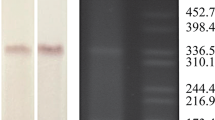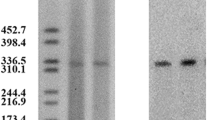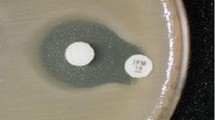Abstract
In an earlier study from this laboratory, Vibrio fluvialis BD146, a clinical isolate from Kolkata, India, 2002, was found to be resistant to all the fourteen antibiotics tested. It harboured a high copy number plasmid pBD146 and a low copy number plasmid. In the present study, a more detailed analysis was carried out to unravel different resistance mechanisms in this isolate. Sequencing showed that variable region of class 1 integron located on low copy number plasmid harbored arr3-cmlA-bla OXA10-aadA1 gene cassettes. Analysis for extended spectrum beta lactamases (ESBLs) revealed that BD146 was ESBL positive. Efflux pumps were involved in the drug resistance phenotype for chloramphenicol, kanamycin, streptomycin and tetracycline. Sequence analysis of pBD146 revealed the presence of genes encoding BDint an integrase with a unique sequence having little similarity to other known integrases, toxin–antitoxin (parE/parD), a replicase, trimethoprim resistance (dfrVI) and quinolone resistance (qnrVC5). Presence of cmlA, putative novel integrase and toxin–antitoxin system in V. fluvialis has been documented for the first time in this report. pBD146 showed 99% sequence similarity with pVN84 from V. cholerae O1 of Vietnam, 2004 and a plasmid from V. parahaemolyticus v110 of Hong Kong, 2010. Conjugation experiments proved the ability of pBD146 and the low copy number plasmid, to get transferred to another host imparting their antibiotic resistance traits to the transconjugants. Therefore, present study has indicated that plasmids played an important role for dissemination of drug resistance.


Similar content being viewed by others
References
Faruque SM, Albert MJ, Mekalanos JJ (1998) Epidemiology, genetics, and ecology of toxigenic Vibrio cholerae. Microbiol Mol Biol Rev 62:1301–1314
Morris JG Jr (2003) Cholera and other types of vibriosis: a story of human pandemics and oysters on the half shell. Clin Infect Dis 37:272–280. https://doi.org/10.1086/375600
Rajpara N, Patel A, Tiwari N, Bahuguna J, Antony A, Choudhury I, Ghosh A, Jain R, Bhardwaj AK (2009) Mechanism of drug resistance in a clinical isolate of Vibrio fluvialis: involvement of multiple plasmids and integrons. Int J Antimicrob Agents 34:220–225. https://doi.org/10.1016/j.ijantimicag.2009.03.020
Ramamurthy T, Sharma NC (2014) Cholera outbreaks in India. Curr Top Microbiol Immunol 379:49–85. https://doi.org/10.1007/82_2014_368
Singh R, Rajpara N, Tak J, Patel A, Mohanty P, Vinothkumar K, Chowdhury G, Ramamurthy T, Ghosh A, Bhardwaj AK (2012) Clinical isolates of Vibrio fluvialis from Kolkata, India, obtained during 2006: plasmids, the qnr gene and a mutation in gyrase A as mechanisms of multidrug resistance. J Med Microbiol 61:369–374. https://doi.org/10.1099/jmm.0.037226-0
Bhardwaj AK, Vinothkumar K (2015) Evolution of MDRs. In: Kalia VC (ed) Quorum sensing vs quorum quenching: a battle with no end in sight. Springer, New Delhi, pp 9–22
Cambray G, Guerout AM, Mazel D (2010) Integrons. Annu Rev Genet 44:141–166. https://doi.org/10.1146/annurev-genet-102209-163504
Bhardwaj AK, Vinothkumar K, Rajpara N, Mohanty P, Kutar BM (2014) Therapeutic limitations due to antibiotic drug resistance: road to alternate therapies. In: Atta-ur-Rahman, Choudhary MI (eds) Frontiers in anti-infective drug discovery, vol 3. Bentham Science, Sharjah, pp 72–141
Srinivasan VB, Virk RK, Kaundal A, Chakraborty R, Datta B, Ramamurthy T, Mukhopadhyay AK, Ghosh A (2006) Mechanism of drug resistance in clonally related clinical isolates of Vibrio fluvialis isolated in Kolkata, India. Antimicrob Agents Chemother 50:2428–2432. https://doi.org/10.1128/AAC.01561-05
Thungapathra M, Amita Sinha KK, Chaudhuri SR, Garg P, Ramamurthy T, Nair GB, Ghosh A (2002) Occurrence of antibiotic resistance gene cassettes aac(6′)-Ib, dfrA5, dfrA12, and ereA2 in class I integrons in non-O1, non-O139 Vibrio cholerae strains in India. Antimicrob Agents Chemother 46:2948–2955
Clinical Laboratory Standard Institute (2010) Performance standards for antimicrobial susceptibility testing. In: Twentieth informational supplement, Wayne, PA: CLSI:M100-S120
Azmi IJ, Khajanchi BK, Akter F, Hasan TN, Shahnaij M, Akter M, Banik A, Sultana H, Hossain MA, Ahmed MK, Faruque SM, Talukder KA (2014) Fluoroquinolone resistance mechanisms of Shigella flexneri isolated in Bangladesh. PLoS ONE 9:e102533. https://doi.org/10.1371/journal.pone.0102533
Kim JY, Kim SH, Jeon SM, Park MS, Rhie HG, Lee BK (2008) Resistance to fluoroquinolones by the combination of target site mutations and enhanced expression of genes for efflux pumps in Shigella flexneri and Shigella sonnei strains isolated in Korea. Clin Microbiol Infect 14(8):760–765. https://doi.org/10.1111/j.1469-0691.2008.02033.x
Taneja N, Mishra A, Kumar A, Verma G, Sharma M (2015) Enhanced resistance to fluoroquinolones in laboratory-grown mutants & clinical isolates of Shigella due to synergism between efflux pump expression & mutations in quinolone resistance determining region. Indian J Med Res 141:81–89
Kutar BM, Rajpara N, Upadhyay H, Ramamurthy T, Bhardwaj AK (2013) Clinical isolates of Vibrio cholerae O1 El Tor Ogawa of 2009 from Kolkata, India: preponderance of SXT element and presence of Haitian ctxB variant. PLoS ONE 8:e56477. https://doi.org/10.1371/journal.pone.0056477
Roy A, Kucukural A, Zhang Y (2010) I-TASSER: a unified platform for automated protein structure and function prediction. Nat Protoc 5:725–738. https://doi.org/10.1038/nprot.2010.5
Yang J, Roy A, Zhang Y (2013) Protein-ligand binding site recognition using complementary binding-specific substructure comparison and sequence profile alignment. Bioinformatics 29:2588–2595. https://doi.org/10.1093/bioinformatics/btt447
Zhang Y (2008) I-TASSER server for protein 3D structure prediction. BMC Bioinform 9:40. https://doi.org/10.1186/1471-2105-9-40
Fonseca EL, Vicente AC (2013) Epidemiology of qnrVC alleles and emergence out of the Vibrionaceae family. J Med Microbiol 62:1628–1630. https://doi.org/10.1099/jmm.0.062661-0
Kumar P, Thomas S (2009) Presence of dfr6 gene cassette in superintegron of non-O1/non-O139 strain of Vibrio cholerae. Antimicrob Agents Chemother 53:4959–4960. https://doi.org/10.1128/AAC.00540-09
Kumar P, Thomas S (2011) Presence of qnrVC3 gene cassette in SXT and class 1 integrons of Vibrio cholerae. Int J Antimicrob Agents 37:280–281. https://doi.org/10.1016/j.ijantimicag.2010.12.006
Fonseca EL, Dos Santos Freitas F, Vieira VV, Vicente AC (2008) New qnr gene cassettes associated with superintegron repeats in Vibrio cholerae O1. Emerg Infect Dis 14:1129–1131. https://doi.org/10.3201/eid1407.080132
Liu M, Chen S (2013) Draft genome sequence of Vibrio parahaemolyticus V110, isolated from shrimp in Hong Kong. Genome Announc. https://doi.org/10.1128/genomeA.00300-13
Messier N, Roy PH (2001) Integron integrases possess a unique additional domain necessary for activity. J Bacteriol 183:6699–6706. https://doi.org/10.1128/JB.183.22.6699-6706.2001
Vinothkumar K, Kumar GN, Bhardwaj AK (2016) Characterization of Vibrio fluvialis qnrVC5 gene in native and heterologous hosts: synergy of qnrVC5 with other determinants in conferring quinolone resistance. Front Microbiol 7:146. https://doi.org/10.3389/fmicb.2016.00146
Chowdhury G, Pazhani GP, Sarkar A, Rajendran K, Mukhopadhyay AK, Bhattacharya MK, Ghosh A, Ramamurthy T (2016) Carbapenem resistance in clonally distinct clinical strains of Vibrio fluvialis isolated from diarrheal samples. Emerg Infect Dis 22:1754–1761. https://doi.org/10.3201/eid2210.151612
Chowdhury G, Pazhani GP, Nair GB, Ghosh A, Ramamurthy T (2011) Transferable plasmid-mediated quinolone resistance in association with extended-spectrum beta-lactamases and fluoroquinolone-acetylating aminoglycoside-6′-N-acetyltransferase in clinical isolates of Vibrio fluvialis. Intl J Antimicrob Agents 38:169–173. https://doi.org/10.1016/j.ijantimicag.2011.04.013
Mohanty P, Patel A, Kushwaha Bhardwaj A (2012) Role of H- and D-MATE-type transporters from multidrug resistant clinical isolates of Vibrio fluvialis in conferring fluoroquinolone resistance. PLoS ONE 7:e35752. https://doi.org/10.1371/journal.pone.0035752
Unterholzner SJ, Poppenberger B, Rozhon W (2013) Toxin–antitoxin systems: biology, identification, and application. Mob Genet Elem 3:e26219. https://doi.org/10.4161/mge.26219
Acknowledgements
The authors are grateful to Drs. Amit Ghosh and T. Ramamurthy, NICED, Kolkata, India, for providing the Vibrio strains and for their invaluable advice and support. The authors also thankfully acknowledge The Puri Foundation for Education in India for providing infrastructure facilities. Ms. Neha Rajpara is a recipient of senior research fellowship from Indian Council of Medical Research (ICMR), New Delhi, India (AMR/49/11-ECDI). The technical support and advice provided by Mr. Priyabrata Mohanty and Mr. K. Vinothkumar is thankfully acknowledged.
Author information
Authors and Affiliations
Corresponding author
Ethics declarations
Conflict of interest
The authors declare that they have no conflict of interest.
Electronic supplementary material
Below is the link to the electronic supplementary material.
Rights and permissions
About this article
Cite this article
Rajpara, N., Nair, M. & Bhardwaj, A.K. A Highly Promiscuous Integron, Plasmids, Extended Spectrum Beta Lactamases and Efflux Pumps as Factors Governing Multidrug Resistance in a Highly Drug Resistant Vibrio fluvialis Isolate BD146 from Kolkata, India. Indian J Microbiol 58, 60–67 (2018). https://doi.org/10.1007/s12088-017-0687-8
Received:
Accepted:
Published:
Issue Date:
DOI: https://doi.org/10.1007/s12088-017-0687-8




